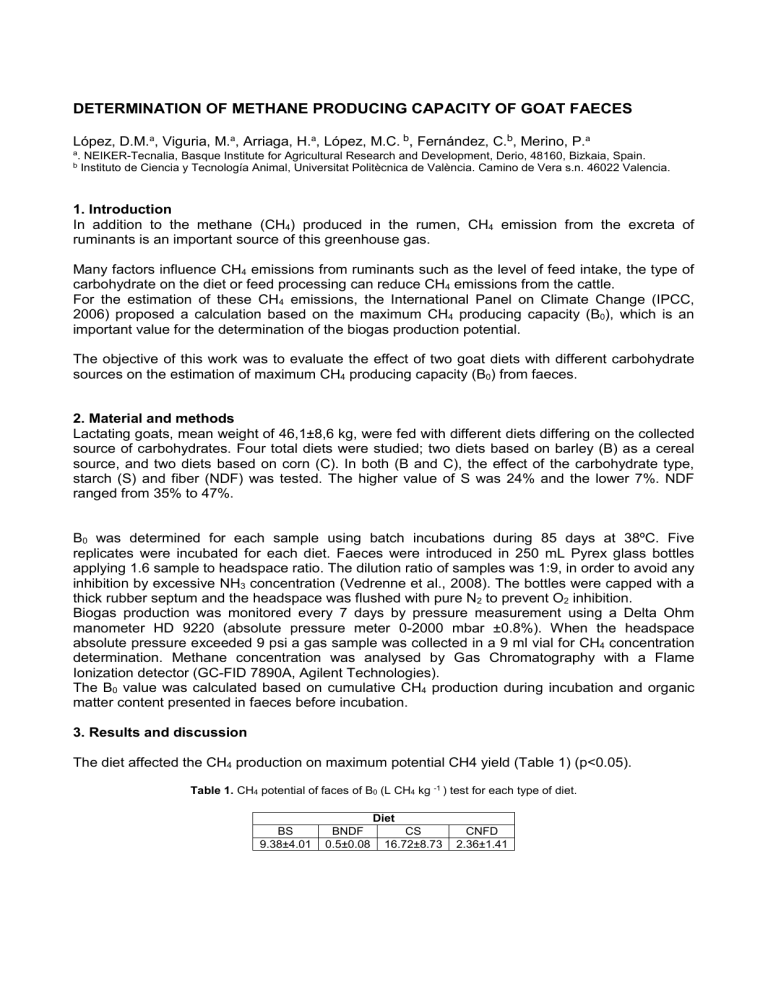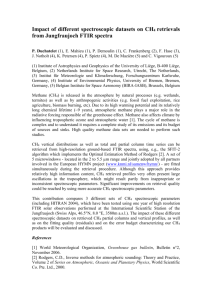Sample Paper - Red Remedia

DETERMINATION OF METHANE PRODUCING CAPACITY OF GOAT FAECES
López, D.M.
a , Viguria, M.
a , Arriaga, H.
a , López, M.C.
b , Fernández, C.
b
, Merino, P.
a a . NEIKER-Tecnalia, Basque Institute for Agricultural Research and Development, Derio, 48160, Bizkaia, Spain. b Instituto de Ciencia y Tecnología Animal, Universitat Politècnica de València. Camino de Vera s.n. 46022 Valencia.
1. Introduction
In addition to the methane (CH
4
) produced in the rumen, CH
4
emission from the excreta of ruminants is an important source of this greenhouse gas.
Many factors influence CH
4
emissions from ruminants such as the level of feed intake, the type of carbohydrate on the diet or feed processing can reduce CH
4
emissions from the cattle.
For the estimation of these CH
4
emissions, the International Panel on Climate Change (IPCC,
2006) proposed a calculation based on the maximum CH
4
producing capacity (B
0
), which is an important value for the determination of the biogas production potential.
The objective of this work was to evaluate the effect of two goat diets with different carbohydrate sources on the estimation of maximum CH
4
producing capacity (B
0
) from faeces.
2. Material and methods
Lactating goats, mean weight of 46,1±8,6 kg, were fed with different diets differing on the collected source of carbohydrates. Four total diets were studied; two diets based on barley (B) as a cereal source, and two diets based on corn (C). In both (B and C), the effect of the carbohydrate type, starch (S) and fiber (NDF) was tested. The higher value of S was 24% and the lower 7%. NDF ranged from 35% to 47%.
B
0
was determined for each sample using batch incubations during 85 days at 38ºC. Five replicates were incubated for each diet. Faeces were introduced in 250 mL Pyrex glass bottles applying 1.6 sample to headspace ratio. The dilution ratio of samples was 1:9, in order to avoid any inhibition by excessive NH
3
concentration (Vedrenne et al., 2008). The bottles were capped with a thick rubber septum and the headspace was flushed with pure N
2
to prevent O
2
inhibition.
Biogas production was monitored every 7 days by pressure measurement using a Delta Ohm manometer HD 9220 (absolute pressure meter 0-2000 mbar ±0.8%). When the headspace absolute pressure exceeded 9 psi a gas sample was collected in a 9 ml vial for CH
4
concentration determination. Methane concentration was analysed by Gas Chromatography with a Flame
Ionization detector (GC-FID 7890A, Agilent Technologies).
The B
0
value was calculated based on cumulative CH
4
production during incubation and organic matter content presented in faeces before incubation.
3. Results and discussion
The diet affected the CH
4
production on maximum potential CH4 yield (Table 1) (p<0.05).
Table 1.
CH
4
potential of faces of B
0
(L CH
4
kg -1 ) test for each type of diet.
Diet
BS BNDF CS CNFD
9.38±4.01 0.5±0.08 16.72±8.73 2.36±1.41
This study showed that faeces derived from diets using NFD give lower B
0
values than starch based diets (p<0.05). This is likely to be because feeding ruminants with fiber-rich diets, can produce faeces which contain larger amounts of slowly degradable carbohydrates (Moller et al.,
2004).
The production of CH
4
is rather similar for barley and corn diets containing fiber as carbohydrate, which can be explained by the similar diet %NFD content.
The B
0
value obtained from diets based on starch as carbohydrate was higher on corn than on barley diets but is not significant. This can be explained by the higher fiber content of barley treatments and probably less degradable.
4. Conclusion
The effect of fiber as carbohydrate on diets produced faeces with lower methane producing capacity.
5. Acknowledgements
This work was cofinanced by the Ministerio de Ciencia e Innovación. INIA. RTA 2011-00107-C02-
01.
References
Bannink, A.; Smits, M.C.J., Kebreab, E.; Mills, J.A.N., Ellis, J.L., Klop, A., France, J., Dijkstra, J. 2010.
Simmulating the effect of grassland management and grass ensiling on methane emission from lactating cows. J. Agric. Sci., 148, 55-72.
IPCC, 2006. IPPC Guidelines for national greenhouse gas inventories, vol. 4. Agriculture, forestry and other land use. In: Eggleston, H.S., Buendia, L., Miwa, K., Ngara, T. Tanabe, K. (Eds.) (2006). Prepared by the
National Greenhouse Gas Inventories Programme IGES, Hayama, Japan.
Jarret G., Martinez J. and Dourmad J., 2011. Pig feeding strategy coupled with effluent management - fresh or stored slurry, solid phase separation - on methane potential and methane conversion factors during storage. Atmospheric Environment, vol. 45, 34, 6204-6209.
Moller, H., Sommer, S.,Ahring, B. ,2004. Methane productivity of manure, straw and solid fractions of manure. Biomass & Bioenergy, vol. 26, 5,485-495.
Vedrenne F., Béline F., Dabert P. and Bernet, N., 2008. The effect of incubation conditions on the laboratory measurement of the methane producing capacity of livestock measurement wastes. Bioresource
Technology, vol. 99, 1, 46-155.







